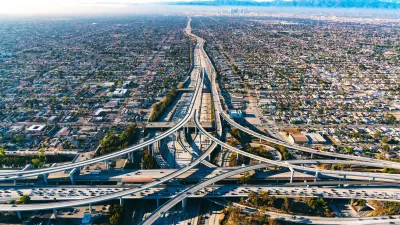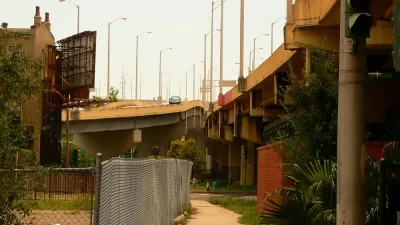With the new administration placing racial justice and equity at the forefront of transportation policy, will America finally reckon with the legacy of its freeways?

In a piece for Common Edge, William Fulton describes a scene that's all too common in many American cities: a dense, walkable downtown, brimming with diverse uses and businesses, sliced through by a massive freeway overpass. "In almost every urban location I have ever lived, a midcentury transportation scar stretches across the landscape and makes navigation difficult for pedestrians," writes Fulton. These scars reveal the inequities of top-down policies whose effects continue to reverberate throughout communities, even as city leaders attempt to redress past injustices and rectify their negative impacts.
"The complicated truth is that even as these freeways destroyed and divided neighborhoods, they also provided regional access to downtowns and other central-city locations that were struggling in the postwar suburban era. And in recent years they may have helped the rebirth of urban neighborhoods by giving city residents easy driving access to suburban job centers and also giving shoppers easy access to historic Main Streets."
The current "Big Rethink" around highways is an opportunity to challenge assumptions and find creative ways to repair the damage without sacrificing mobility. Around the country, cities are looking at ways to replace elevated freeways with boulevards, build freeway caps (which create valuable public and private real estate, albeit still near a major source of air pollution), and reduce the number of on and off-ramps to increase land available for other uses while maintaining the flow of traffic. "Healing urban scars and reclaiming the urban environment comes with a steep price tag—and doesn’t always expand freeway capacity, which is usually the primary driver of state and federal transportation funding," Fulton says, but successful examples like Dallas's Klyde Warren Park and San Francisco's Embarcadero show that alternatives are possible.
FULL STORY: Repairing the Urban Fabric Ruined by Highways

Planetizen Federal Action Tracker
A weekly monitor of how Trump’s orders and actions are impacting planners and planning in America.

The Simple Legislative Tool Transforming Vacant Downtowns
In California, Michigan and Georgia, an easy win is bringing dollars — and delight — back to city centers.

San Francisco's School District Spent $105M To Build Affordable Housing for Teachers — And That's Just the Beginning
SFUSD joins a growing list of school districts using their land holdings to address housing affordability challenges faced by their own employees.

In More Metros Than You’d Think, Suburbs are Now More Expensive Than the City
If you're moving to the burbs to save on square footage, data shows you should think again.

The States Losing Rural Delivery Rooms at an Alarming Pace
In some states, as few as 9% of rural hospitals still deliver babies. As a result, rising pre-term births, no adequate pre-term care and "harrowing" close calls are a growing reality.

The Small South Asian Republic Going all in on EVs
Thanks to one simple policy change less than five years ago, 65% of new cars in this Himalayan country are now electric.
Urban Design for Planners 1: Software Tools
This six-course series explores essential urban design concepts using open source software and equips planners with the tools they need to participate fully in the urban design process.
Planning for Universal Design
Learn the tools for implementing Universal Design in planning regulations.
Smith Gee Studio
City of Charlotte
City of Camden Redevelopment Agency
City of Astoria
Transportation Research & Education Center (TREC) at Portland State University
US High Speed Rail Association
City of Camden Redevelopment Agency
Municipality of Princeton (NJ)





























